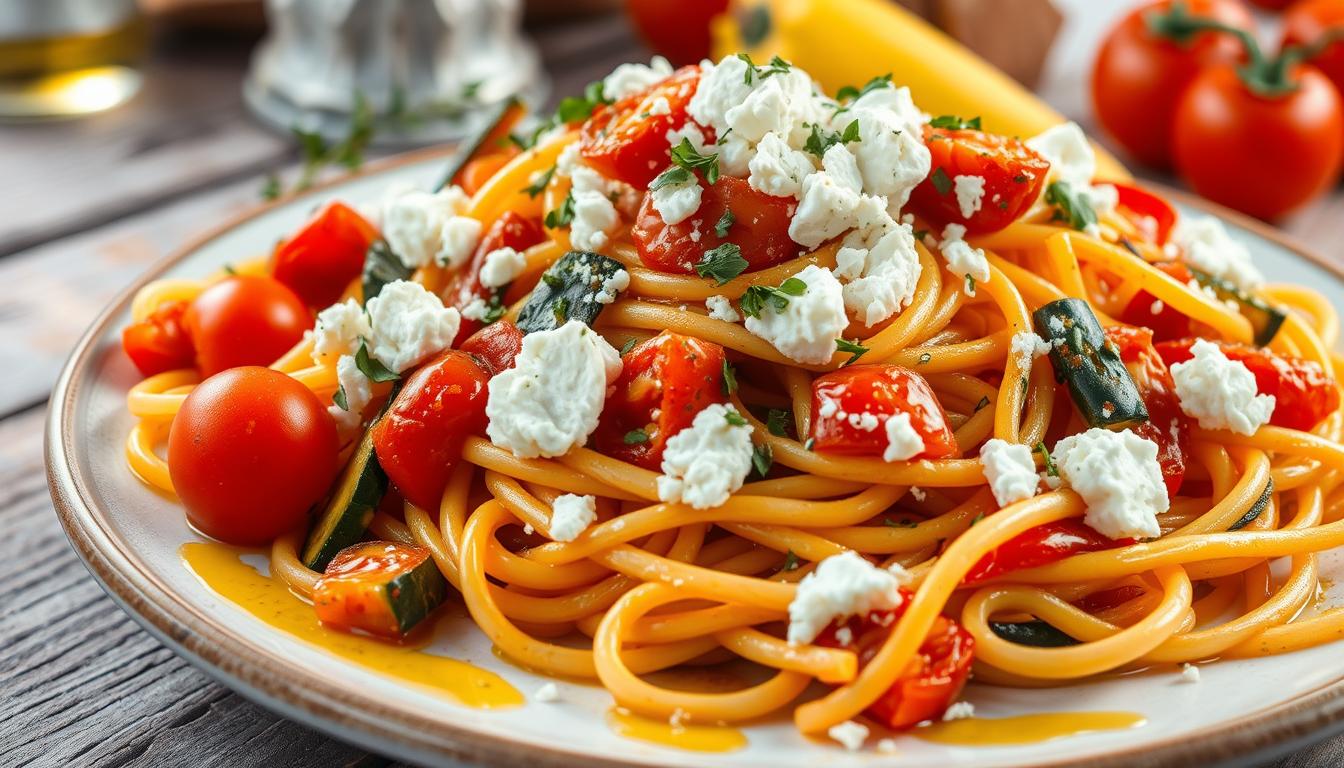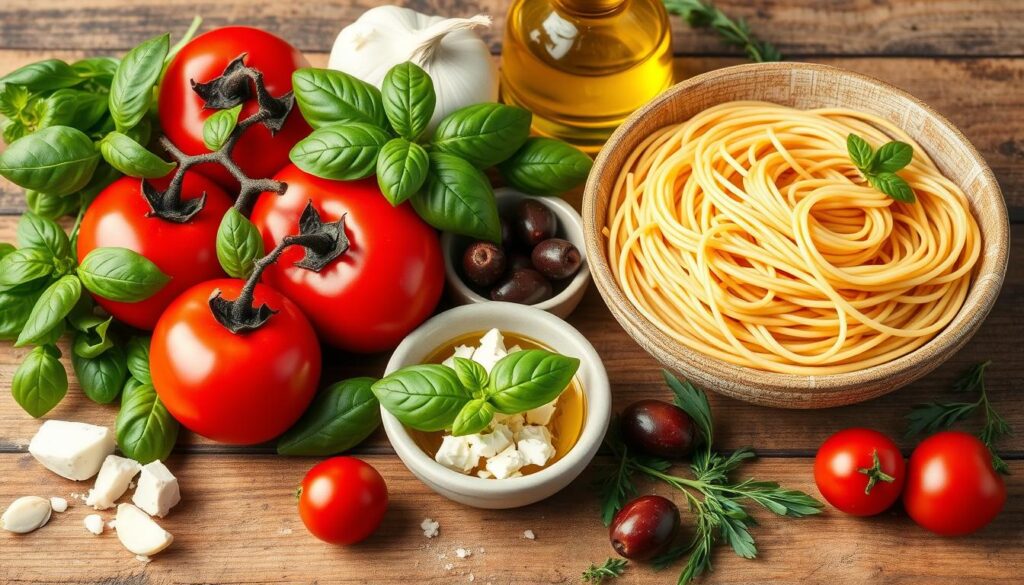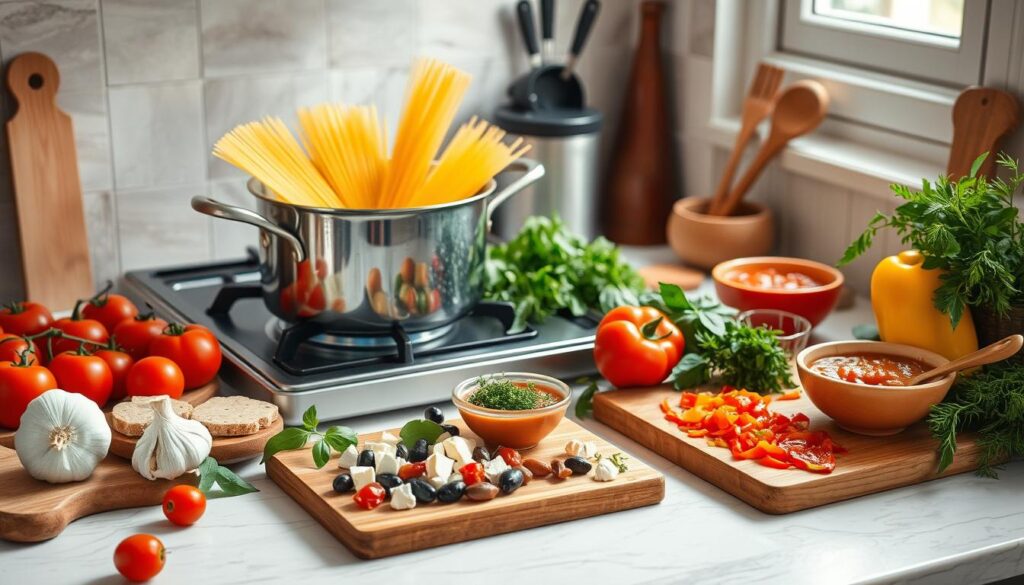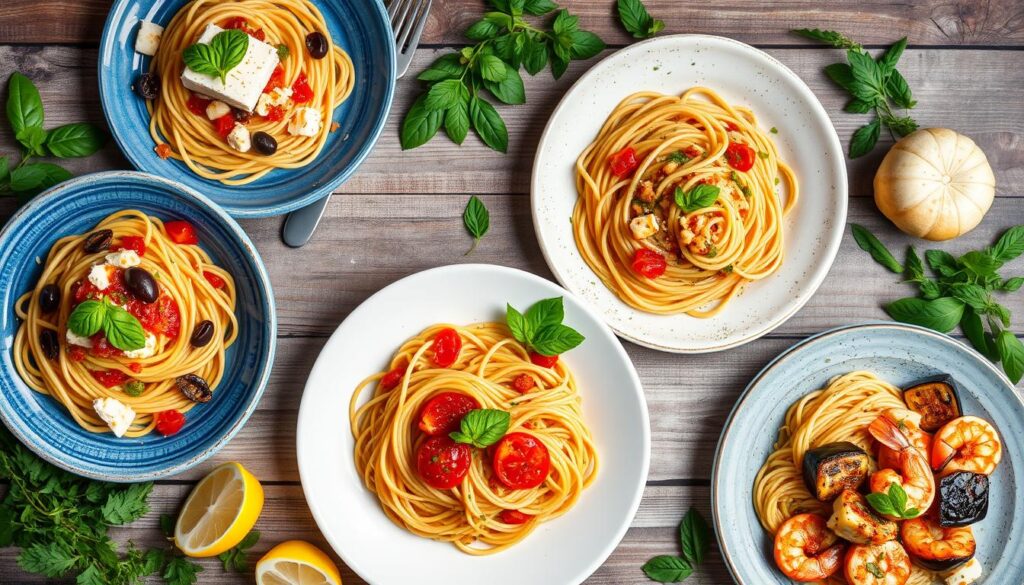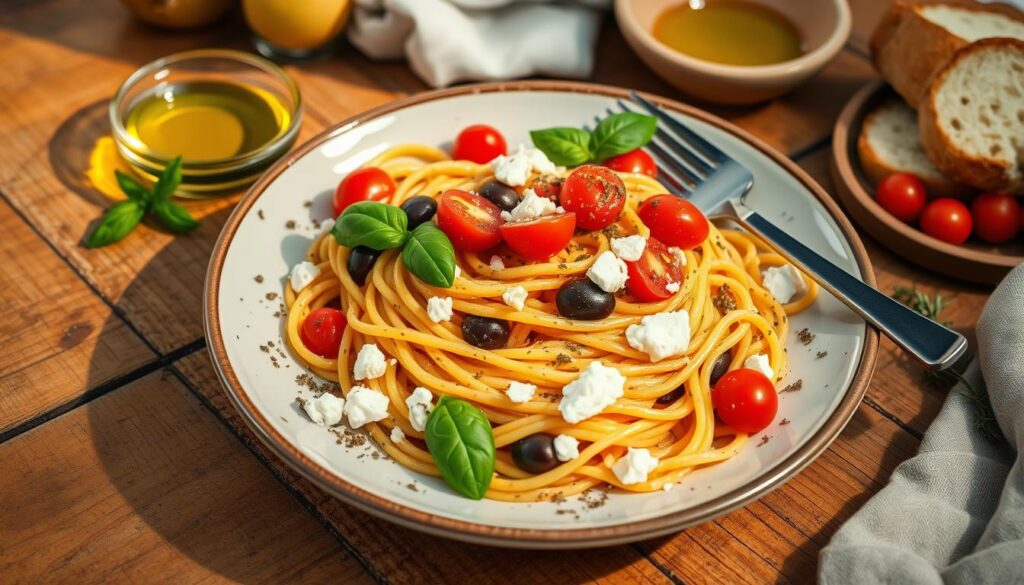Every family has a special recipe that makes any night feel like a celebration. For me, Greek spaghetti is that dish. It’s a Mediterranean pasta that brings out the best in simple cooking in just 15 minutes.
This recipe is more than just a meal; it’s a trip to Greece. With fresh ingredients and bold flavors, it’s easy to see why it’s a favorite for many cooks.
Greek spaghetti is not just about filling your belly. It’s about the Mediterranean way of cooking. It uses fresh ingredients, simple prep, and big flavors. Whether you’re experienced or new to cooking, this recipe will take you to the Greek islands with every bite.
Next, we’ll dive into the history, key ingredients, and easy steps to make authentic Greek spaghetti. It will soon become a favorite in your kitchen.
What is Greek Spaghetti?
Greek spaghetti, also known as makaronia me kima, is a tasty journey through Mediterranean tastes. It’s different from Italian spaghetti because of its special way of making and deep cultural meaning.
Origin and Cultural Significance
Greek spaghetti comes from generations of cooks who made simple things into amazing meals. Makaronia me kima became a favorite in Greek homes. It shows the country’s love for rich, tasty dishes that unite families.
“Food is our common ground, a universal experience.” – James Beard
Key Ingredients
- Spaghetti noodles
- Ground beef or lamb
- Tomato sauce
- Cinnamon
- Onions and garlic
- Fresh herbs
Differences from Traditional Italian Spaghetti
| Characteristic | Greek Spaghetti | Italian Spaghetti |
|---|---|---|
| Spices | Cinnamon, oregano | Basil, oregano |
| Cheese | Feta | Parmesan |
| Meat Preparation | Slow-cooked with spices | Simple meat sauce |
The use of cinnamon and feta cheese makes Greek spaghetti unique. These ingredients give the dish a special taste that shows off Greek cooking.
Essential Ingredients for Greek Spaghetti
To make a true grecian pasta recipe, you need the right ingredients. These turn simple spaghetti into a tasty Greek comfort food. Knowing the key ingredients will help you make a dish that’s both memorable and Mediterranean-inspired.
Types of Pasta to Use
Choosing the right pasta is key for your grecian pasta recipes. Greek spaghetti often uses:
- Classic spaghetti noodles
- Thick, hearty pasta varieties
- Whole wheat spaghetti for added nutrition
Popular Vegetables in the Dish
These essential vegetables make your Greek comfort food stand out:
| Vegetable | Quantity | Preparation |
|---|---|---|
| Grape Tomatoes | 1 cup | Halved |
| Red Onion | 1/2 | Diced |
| Frozen Spinach | 12 oz | Thawed |
Additions for Extra Flavor
These ingredients add extra flavor to your grecian pasta recipes:
- Extra virgin olive oil: 3 tablespoons
- Fresh herbs like basil and dill
- Crumbled feta cheese: 4 oz
- Garlic cloves: 4
- Dried oregano: 1 tablespoon
“The secret to authentic Greek spaghetti lies in the quality of ingredients and the love you put into preparing them.”
By picking and mixing these ingredients carefully, you’ll make a Greek comfort food that’s true to Mediterranean cuisine. Try different amounts and add your own touches to make it uniquely yours.
Step-by-Step Preparation Guide
Making the perfect mediterranean pasta needs focus and a love for real flavors. This guide will help you make a tasty greek spaghetti dish. It will show you how to bring Mediterranean cuisine to your table.
Cooking the Pasta to Perfection
Choosing the right pasta is key for a great greek spaghetti. Use thin spaghetti (spaghettini) for the best sauce absorption. Here’s how to do it right:
- Bring a large pot of salted water to a rolling boil
- Add 16 ounces of spaghetti
- Cook for 8-10 minutes until al dente
- Reserve 1/2 cup of pasta water before draining
Preparing the Signature Sauce
The sauce is the heart of any mediterranean pasta. Make a rich, tasty sauce to make your greek spaghetti stand out:
| Ingredient | Quantity |
|---|---|
| Extra Virgin Olive Oil | 1/2 cup |
| Crushed Tomatoes | 14-15 oz can |
| Dry Red Wine | 1/2 cup |
| Dried Oregano | 1 tablespoon |
Combining Ingredients with Finesse
The last step is to mix everything together to make a perfect greek spaghetti dish. Pro tip: Toss the pasta with the sauce gently. This ensures each strand is coated well.
“The magic of Greek spaghetti lies in the careful balance of flavors and textures.”
- Sauté garlic and onions in olive oil
- Add crushed tomatoes and red wine
- Sprinkle in herbs and spices
- Fold pasta into the sauce
- Top with crumbled feta cheese
Your mediterranean pasta masterpiece is now ready to be served and enjoyed!
Flavoring Your Greek Spaghetti
Creating delicious greek-style noodles is all about mastering the art of seasoning. Grecian pasta recipes shine when you understand how to balance flavors. Incorporate traditional ingredients that make this dish truly special.
Herbs That Transform Your Dish
The right herbs can elevate your greek-style noodles from ordinary to extraordinary. Consider these essential herbs:
- Fresh basil – adds a bright, aromatic touch
- Dried oregano – provides authentic Greek flavor
- Fresh dill – brings a subtle tangy essence
- Parsley – offers a clean, fresh undertone
Feta: The Crowning Glory
Feta cheese is non-negotiable in authentic Grecian pasta recipes. Crumble about 4 ounces of high-quality feta over your spaghetti. This creates a creamy, tangy layer that transforms the entire dish.
Olives: Adding Authentic Mediterranean Flavor
Kalamata olives bring an unmistakable Greek character to your pasta. Slice them thinly and scatter generously throughout the dish. This introduces a rich, briny flavor that complements the other ingredients.
“The secret to great Greek spaghetti lies in the quality of your ingredients and the love you put into preparing them.” – Greek Culinary Tradition
When preparing your grecian pasta recipes, remember that seasoning is an art. Start with small amounts of herbs and spices, taste, and adjust. Your goal is a harmonious blend that celebrates the vibrant flavors of Mediterranean cuisine.
Common Variations of Greek Spaghetti
Greek pasta dishes are very versatile. You can change a classic recipe into many tasty versions. Whether you like vegetarian, seafood, or meat dishes, Greek spaghetti can be made to fit your taste and diet.
Vegetarian Delights
Vegetarian options for pastitsio and Greek spaghetti are both healthy and delicious. Here are some plant-based choices:
- 24 oz of plant-based ground meat (Beyond or Impossible)
- Roasted vegetables like eggplant and zucchini
- Mushroom medley for added umami flavor
- Lentils or chickpeas for protein boost
Seafood Sensations
Greek cuisine loves seafood, and you can add marine flavors to your spaghetti:
- 2 pounds of fresh or frozen shrimp
- Grilled octopus chunks
- Sautéed calamari rings
- Flaky white fish like cod or sea bass
Meat Variations
Meat lovers will enjoy the protein-rich options in Greek spaghetti:
- Ground lamb with traditional spices
- Slow-cooked beef with cinnamon
- Roasted chicken with Mediterranean herbs
- Braised pork with red wine sauce
| Variation Type | Primary Protein | Key Seasonings |
|---|---|---|
| Vegetarian | Plant-based meat | Oregano, Thyme |
| Seafood | Shrimp | Garlic, Parsley |
| Meat | Lamb | Cinnamon, Allspice |
Try these variations to find your favorite Greek spaghetti recipe. Each one brings a unique taste of Mediterranean cooking.
Serving Suggestions for Greek Spaghetti
Make your mediterranean pasta a hit by thinking about how to present it. Greek comfort food is best when served with dishes that bring out its flavors.
Ideal Accompaniments
Here are some great side dishes for your Greek spaghetti:
- Crisp Greek salad with cucumber and olives
- Warm garlic bread
- Roasted Mediterranean vegetables
- Tzatziki sauce for dipping
Wine Pairings
Choose wines that match the bold tastes of your pasta:
| Wine Type | Flavor Profile | Recommended Pairing |
|---|---|---|
| Assyrtiko | Crisp, mineral | Seafood-based Greek spaghetti |
| Agiorgitiko | Light red, fruity | Meat-based Greek spaghetti |
| Moschofilero | Aromatic white | Vegetarian Greek spaghetti |
Presentation Tips
Make your dish look as good as it tastes with these tips:
- Use a wide, white plate to showcase colors
- Sprinkle fresh chopped parsley on top
- Crumble extra feta cheese for garnish
- Drizzle high-quality olive oil
“In Greek cuisine, presentation is as important as taste. Every dish tells a story of tradition and passion.” – Greek Culinary Expert
Your mediterranean pasta will not only taste amazing but also look great. Follow these serving tips to make it Instagram-worthy.
Storing Leftover Greek Spaghetti
Keeping your greek spaghetti fresh is key. You can enjoy it for days with the right storage and reheating. This way, you can savor your greek pasta dishes for a while.
Best Storage Practices
Storing your greek spaghetti right is important. It keeps the taste and texture great. Here are some tips to follow:
- Use an airtight container to prevent moisture and bacterial growth
- Allow the pasta to cool to room temperature before refrigerating
- Separate sauce from pasta if possible to prevent soggy noodles
- Store in the refrigerator within two hours of cooking
Reheating Techniques
Bring back the flavor of your leftover greek S with these methods:
| Reheating Method | Time | Tips |
|---|---|---|
| Stovetop | 2-5 minutes | Add a splash of olive oil to prevent sticking |
| Microwave | 1-1.5 minutes | Stir every 30 seconds for even heating |
| Oven | 15-20 minutes | Bake at 350°F for a crispy texture |
How Long It Lasts in the Fridge
Your greek spaghetti stays fresh in the fridge for 4-5 days. Freezing it can keep it good for 3-6 months.
“The key to great leftovers is proper storage and gentle reheating” – Greek Culinary Experts
Always check for spoilage before eating stored greek S. If unsure, it’s safer to throw it away.
Frequently Asked Questions
When making grecian pasta recipes, many home cooks have questions. This section answers the most common ones. It helps you make an authentic and tasty dish.
Can I Make Greek Spaghetti Gluten-Free?
Yes, you can make greek-style noodles gluten-free. Here are some alternatives:
- Gluten-free pasta made from rice flour
- Chickpea pasta
- Quinoa-based spaghetti
- Zucchini noodles for a low-carb option
Pro tip: Cooking times may vary with gluten-free pasta. Adjust as needed.
What Are the Best Substitutes for Feta?
| Cheese Substitute | Flavor Profile | Best Used In |
|---|---|---|
| Goat Cheese | Tangy, creamy | Grecian pasta recipes with mild flavors |
| Ricotta Salata | Mild, slightly salty | Cold greek-style noodle dishes |
| Cotija Cheese | Salty, crumbly | Dishes requiring textured cheese topping |
Is It Possible to Freeze Greek Spaghetti?
Greek S can be frozen successfully. Here’s how:
- Cool the dish completely before freezing
- Store in airtight containers
- Consume within 3 months for best quality
- Thaw in refrigerator overnight before reheating
“Great recipes are meant to be shared and preserved!” – Greek Culinary Tradition
Remember, you can adjust grecian pasta recipes to fit your needs. Try different things to find your favorite version.
Tips for Perfecting Your Recipe
Mastering Greek comfort food takes time and love. Your mediterranean pasta can go from good to great with a few tips and tricks.
Common Mistakes to Avoid
Creating authentic Greek comfort food needs focus. Here are mistakes to avoid:
- Overcooking pasta until it becomes mushy
- Using low-quality olive oil
- Skipping fresh herb garnishes
- Not reserving pasta water for sauce consistency
Adjusting for Personal Taste
Every mediterranean pasta recipe can be your own. Try different amounts and flavors to make it special.
| Ingredient | Adjustment Tip |
|---|---|
| Feta Cheese | Increase or decrease based on preference |
| Herbs | Mix fresh herbs for complex flavor |
| Olive Oil | Use high-quality extra virgin olive oil |
Experimenting with Ingredients
Your Greek comfort food journey is all about being creative. Try adding unique ingredients like:
- Roasted red peppers
- Grilled artichoke hearts
- Sundried tomatoes
- Kalamata olives
“Cooking is an art, and every dish tells a story of flavor and tradition.”
The secret to amazing mediterranean pasta is balancing flavors. Use fresh, high-quality ingredients. Trust your taste and enjoy the journey!
Conclusion and Final Thoughts
Greek spaghetti is more than a meal; it’s a journey through Mediterranean flavors. It turns your kitchen into a lively Greek taverna. This dish combines simple ingredients to create a comfort food that connects you to centuries of tradition.
Your journey through Greek comfort food doesn’t stop here. With a prep time of about 30 minutes and many ways to customize, this recipe encourages creativity. It’s also a healthy choice, thanks to olive oil and protein-rich ingredients.
Your Culinary Adventure Awaits
Greek spaghetti is not just a recipe; it’s a way of cooking that celebrates fresh ingredients and bold flavors. It’s perfect for both seasoned cooks and kitchen beginners. Feel free to try new things, swap ingredients, and make it your own.
Share Your Greek Spaghetti Story
We’d love to hear about your Greek spaghetti experience. Did you add a special twist? Find a new favorite ingredient? Share your story in the comments below. Let’s inspire others to try Greek spaghetti.
FAQ
Is Greek spaghetti different from traditional Italian spaghetti?
Yes, Greek spaghetti is quite different from Italian spaghetti. Both use pasta, but Greek dishes add Mediterranean flavors. You’ll find feta cheese, Kalamata olives, and herbs like oregano and mint.
The sauces and cooking methods are also unique. Greek dishes often have tomato-based sauces with ground meat. Or, they might use olive oil-based sauces.
Can I make Greek spaghetti gluten-free?
Absolutely! You can make Greek spaghetti gluten-free by using gluten-free pasta. Try chickpea pasta, rice noodles, or gluten-free wheat pasta. Make sure all ingredients are gluten-free for the best taste.
What are the best substitutes for feta cheese?
If you can’t use feta, try these alternatives: goat cheese for a tangy flavor, ricotta salata for a milder taste, or plant-based cheese for vegan options. Each will add a unique twist to your dish while keeping it creamy.
How long can I store Greek spaghetti in the refrigerator?
You can store Greek spaghetti in the fridge for 3-5 days. Keep it in an airtight container. Store pasta and sauce separately if you can.
When reheating, add olive oil or water. This helps the pasta stay moist.
Is it possible to freeze Greek spaghetti?
Yes, you can freeze Greek spaghetti. Pasta without creamy sauces freezes best. Store it in an airtight container or freezer bag for up to 2-3 months.
When thawing, defrost it in the fridge overnight. Then, reheat it gently to avoid mushy pasta.
What are some popular variations of Greek spaghetti?
Greek spaghetti has many tasty variations. You can make vegetarian versions with roasted vegetables, seafood dishes with shrimp or calamari, or meat-based dishes like Makaronia Me Kima with ground beef or lamb.
Feel free to try different proteins and vegetables to find your favorite.
What herbs work best in spaghetti?
Traditional Greek herbs include oregano, mint, parsley, and dill. These herbs add authentic Mediterranean flavors. Fresh herbs are best, but dried ones work too.
Don’t be afraid to experiment and find your perfect herb mix!
What is the difference between Greek spaghetti and Italian spaghetti?
Greek spaghetti often includes flavors like cinnamon, nutmeg, or allspice in the sauce, and may be topped with grated cheeses like Mizithra or Kefalotyri. Italian spaghetti focuses on olive oil, garlic, tomato, and herbs like basil and oregano.
What is the famous pasta dish in Greece?
Pastitsio is a famous Greek pasta dish, layered with tubular pasta, spiced meat sauce, and béchamel, similar to lasagna.
What is the name of Greek pasta?
Greek pasta includes varieties like Kritharaki (orzo), Hilopites (flat egg noodles), and Makarounes (handmade pasta).
What is the Greek word for spaghetti?
The Greek word for spaghetti is “Makaronia” (Μακαρόνια).

